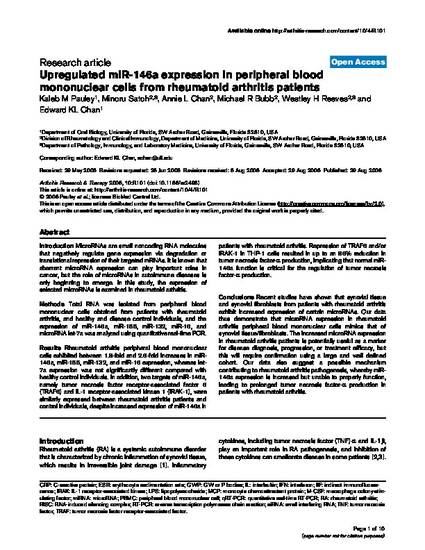
Introduction
MicroRNAs are small noncoding RNA molecules that negatively regulate gene expression via degradation or translational repression of their targeted mRNAs. It is known that aberrant microRNA expression can play important roles in cancer, but the role of microRNAs in autoimmune diseases is only beginning to emerge. In this study, the expression of selected microRNAs is examined in rheumatoid arthritis. Methods
Total RNA was isolated from peripheral blood mononuclear cells obtained from patients with rheumatoid arthritis, and healthy and disease control individuals, and the expression of miR-146a, miR-155, miR-132, miR-16, and microRNA let-7a was analyzed using quantitative real-time PCR. Results
Rheumatoid arthritis peripheral blood mononuclear cells exhibited between 1.8-fold and 2.6-fold increases in miR-146a, miR-155, miR-132, and miR-16 expression, whereas let-7a expression was not significantly different compared with healthy control individuals. In addition, two targets of miR-146a, namely tumor necrosis factor receptor-associated factor 6 (TRAF6) and IL-1 receptor-associated kinase 1 (IRAK-1), were similarly expressed between rheumatoid arthritis patients and control individuals, despite increased expression of miR-146a in patients with rheumatoid arthritis. Repression of TRAF6 and/or IRAK-1 in THP-1 cells resulted in up to an 86% reduction in tumor necrosis factor-α production, implicating that normal miR-146a function is critical for the regulation of tumor necrosis factor-α production. Conclusions
Recent studies have shown that synovial tissue and synovial fibroblasts from patients with rheumatoid arthritis exhibit increased expression of certain microRNAs. Our data thus demonstrate that microRNA expression in rheumatoid arthritis peripheral blood mononuclear cells mimics that of synovial tissue/fibroblasts. The increased microRNA expression in rheumatoid arthritis patients is potentially useful as a marker for disease diagnosis, progression, or treatment efficacy, but this will require confirmation using a large and well defined cohort. Our data also suggest a possible mechanism contributing to rheumatoid arthritis pathogenesis, whereby miR-146a expression is increased but unable to properly function, leading to prolonged tumor necrosis factor-α production in patients with rheumatoid arthritis.
Available at: http://works.bepress.com/kaleb_pauley/18/
